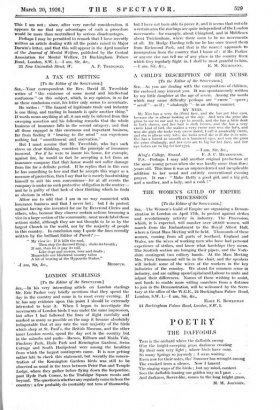LONDON STARLINGS
[To the Editor of the SPECTATOR.]
Sm,—In his very interesting article on London starlings Mr. Eric Parker very briefly mentions that they spend the day in the country and come in to roost every evening. If he has any evidence upon this point I should be extremely interested to hear it. When I began to investigate the movements of London birds I was under the same impression, but after I had followed the lines of flight carefully and marked as many as possible on the map it became absolutely indisputable that at any rate the vast majority of the birds which sleep at St. Paul's, the British Museum, and the other inner London roosts, spend ,the day not in the country but in the suburbs and parks—Barnes, Kilburn and Maida Vale, Finsbury Park, Hyde Park and Kensington Gardens, Swiss Cottage and South Han{pstead were among the localities from which the largest contingents came. It is now getting rather late to cheek this statement, but recently the concen- tration of the Kensington Gardens birds was still to be- observed as usual in the trees between Peter Pan and Temple Lodge, where they gather before flying down the Serpentine, past Hyde Park Corner, to the Trafalgar Square roosts and beyond. The question is whether any regularly come in from the country : a few probably do (certainly not tens of thousands), but I have not been able to prove it, and it seems that outside a certain area the starlings are quite independent of the London movements—for example, about Chingford, and in Middlesex about Twickenham, where there seem to be no movements at all. Mr. Rudge Harding tells me he has once traced them from Richmond Park, and that is the nearest approach to immigration from the country that I know of : if Mr. Parker or anyone else can tell me of any place in the country from which they regularly flight in, I shall be most grateful to him.


























































 Previous page
Previous page